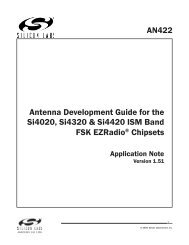C8051F326/7 - Silicon Labs
C8051F326/7 - Silicon Labs
C8051F326/7 - Silicon Labs
Create successful ePaper yourself
Turn your PDF publications into a flip-book with our unique Google optimized e-Paper software.
<strong>C8051F326</strong>/7<br />
14.1.1. Mode 0: 13-bit Timer<br />
Timer 0 and Timer 1 operate as 13-bit timers in Mode 0. The following describes the configuration and<br />
operation of Timer 0. However, both timers operate identically, and Timer 1 is configured in the same manner<br />
as described for Timer 0.<br />
The TH0 register holds the eight MSBs of the 13-bit timer. TL0 holds the five LSBs in bit positions TL0.4-<br />
TL0.0. The three upper bits of TL0 (TL0.7-TL0.5) are indeterminate and should be masked out or ignored<br />
when reading. As the 13-bit timer register increments and overflows from 0x1FFF (all ones) to 0x0000, the<br />
timer overflow flag TF0 (TCON.5) is set and an interrupt will occur if Timer 0 interrupts are enabled.<br />
Setting the TR0 bit (TCON.4) enables the timer when either GATE0 (TMOD.3) is logic 0 or GATE0 is logic<br />
1 and the input signal /INT0 is active. Setting GATE0 to logic 1 allows the timer to be controlled by the<br />
external input signal /INT0, facilitating pulse width measurements. When GATE0 is set to logic 1, the /INT0<br />
input pin is P0.2.<br />
Table 14.2. Timer 0 Operation<br />
TR0 GATE0 /INT0 Timer<br />
0 X X Disabled<br />
1 0 X Enabled<br />
1 1 0 (P0.2 High) Disabled<br />
1 1 1 (P0.2 Low) Enabled<br />
X = Don't Care<br />
See Table 6.4 on page 49 for detailed information on how GATE0 affects /INT0 functionality.<br />
Setting TR0 does not force the timer to reset. The timer registers should be loaded with the desired initial<br />
value before the timer is enabled. TL1 and TH1 form the 13-bit register for Timer 1 in the same manner as<br />
described above for TL0 and TH0. Timer 1 is configured and controlled using the relevant TCON and<br />
TMOD bits just as with Timer 0. The input signal /INT1 is used with Timer 1. See Section “6.3.2. External<br />
Interrupts” on page 49 for a complete description of /INT0 and /INT1.<br />
TMOD<br />
G C T T G C T T<br />
A / 1 1 A / 0 0<br />
T T M M T T M M<br />
E 1 1 0 E 0 1 0<br />
1 0<br />
Pre-scaled Clock<br />
SYSCLK<br />
GATE0<br />
/INT0<br />
CKCON<br />
T T S S<br />
1 0 C C<br />
M M A A<br />
1 0<br />
TR0<br />
Figure 14.1. T0 Mode 0 Block Diagram<br />
128 Rev. 1.1<br />
0<br />
1<br />
TCLK TL0<br />
(5 bits)<br />
TH0<br />
(8 bits)<br />
TCON<br />
TF1<br />
TR1<br />
TF0<br />
TR0<br />
IE1<br />
IT1<br />
IE0<br />
IT0<br />
Interrupt


